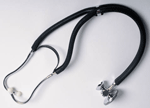There was an interesting story reported on ABC WorldNews last night concerning a wireless heart pressure monitor that is in clinical trials and is causing a stir in the medical community.
The heart pressure monitor, which is described as being about the size of a paper clip, is implanted into a patient's pulmonary artery in a procedure that takes about seven minutes. Once in place, a patient passes a wand over their chest which then powers the implant which in turn transmits the patient's heart mean pressure, systolic pressure, diastolic pressure, heart rate and cardiac output to a receiver that sends the information to a secure web site. The patient's doctor then can review the information at his or her computer or on a hand held device.
The reason why this is such a big deal is that the clinical trial is reporting that patients with the device experienced a 38% reduction in hospitalizations in the first year, which ABC News says is a "huge number in the medical world."
(If someone can tell me what is an "average number" for these types of clinical trials for comparison, I would appreciate it.)
Another reason is that the monitor provides a level of information about a patient's heart that is radically improved over what is generally available to doctors today. The ABC News story says that doctors have typically depended on increases in a patient's weight as reported by daily weigh-ins to give them indications that something might be amiss with the patient's heart.
Dr. William Abraham, a principal researcher in the study was quoted in the story saying that, "We now know that daily weight change is very insensitive to predicting episodes of worsening heart failure."
(I should note that in this 2008 paper titled "Correlation between intrasac pressure measurements of a pressure sensor and an angiographic catheter during endovascular repair of abdominal aortic aneurysm", it says "The 'gold standard' for AAA [abdominal aortic aneurysms] pressure measurements is the use of intrasac catheters (with a sensor tip or fluid column. Nevertheless, a catheter with a fluid column for pressure gauging has limited accuracy, and reading errors may arise from use of an excessively long catheter or an incomplete fluid column due to bubble or thrombus formation. These shortcomings highlight the importance of non-invasive pressure measurement methods.")
The device, called the EndoSure Wireless AAA Pressure Management System, is made by CardioMEMS and was approved for clinical trials in March 2007. It is waiting US Food and Drug Administration final approval, the story says.
A more detailed description of the results found during the clinical trials conducted at the Division of Cardiovascular Medicine at The Ohio State University Medical Center can be found here.
Robert N. Charette is a Contributing Editor to IEEE Spectrum and an acknowledged international authority on information technology and systems risk management. A self-described “risk ecologist,” he is interested in the intersections of business, political, technological, and societal risks. Charette is an award-winning author of multiple books and numerous articles on the subjects of risk management, project and program management, innovation, and entrepreneurship. A Life Senior Member of the IEEE, Charette was a recipient of the IEEE Computer Society’s Golden Core Award in 2008.



